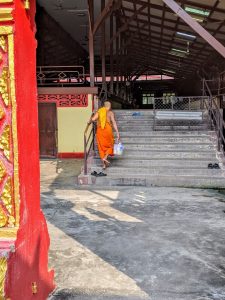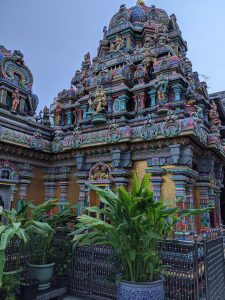

A Thai Buddhist temple is not just one building, but a collection of buildings. It may include not only congregation halls but also a monastery, shrines, school, and sports grounds within a courtyard; a wall encloses some.
I visited different temples during my travel to Thailand. I noticed that some temples were beautiful and pristine, and others were dilapidated and rundown. I could not wrap my head around why this was, so I went straight to the source. I decided to approach a few monks and find out why. Most would not speak to me or couldn’t speak English. But I was lucky to find one monk who spoke a bit of English and was willing to speak with me. I was grateful he was willing to share his worries.

He mentioned that at his temple, they had seen a decline of young adults (millenniums) attend their temple, and they were struggling. Because of the decline at his temple, they only had four monks taking care of the facilities. He was frustrated because it was challenging to keep it up. He felt one of the reasons was that very few young people were attending his temple. He said they worked hard to make sure the temple was running for others who did attend. He also revealed that other temples were lucky and had a dozen or so monks working, but even with that many monks, it was still difficult to take care of the temple.
He was disappointed and sad; he did not see the younger generation attend the temple. The low turnout was influencing his temple. He revealed he was worried that this could cause many temples to close.
After this conversation, I decided to visit some more temples, and I did notice many grandparents and parents with their younger grandchildren or children at the temples, but a lack of millenniums.
I wondered why this generation was not attending?
So again, I went to the source and started to speak with millenniums. Lucky enough, millenniums do speak some English, and they were willing to speak with me. There was a wide range of reasons why they were not attending, and this is what I learned. Some mentioned that the temple was more for their grandparents and parents, but not for them. Others said that they did not have time to go to the temple; they were busy working, but that they still practiced the philosophy of Buddhism. A few said that they were not superstitious like their parents were. I had one young man tell me, “All the faith my parents and grandparent had did not help them have a better life, so why go to the temple?”

The interesting part I learned was that many of the young people still stopped by shrines with an offering such as flowers, generally red drinks or fruit. I noticed that when I stopped by different shrines including the Erawan Shrine, in Bangkok, I did see more millenniums there than I had at many of the temples I visited.
There is not only one reason for the decline of attendance. But one thing is for sure; they are not going to the temple like older generations. I asked myself with this attitude, will temples in Thailand survive the next generation?
Many of the pristine temples in Bangkok, I believe, are surviving because of the large number of tourists visiting them. Tourists generate revenue to help monks maintain the beauty of their temple. Those temples are stunning and beautiful and worth the visit. That is for sure.
This article is not about Buddhism itself. I was just curious why some temples were dilapidated and rundown, and others were thriving.
There are around 30,000 Buddhist temples consecrated in Thailand. The question is, how many temples will survive the millennium generation? Or will it only be the temples visited by tourists that survive this generation?